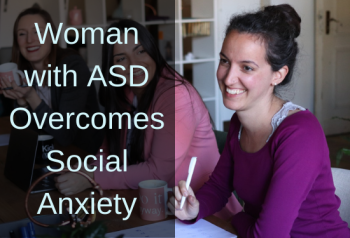Severe Anxiety in Groups, Now Comfortable at Social Gatherings
Submitted by Adrianna Rivas, OTR/L

|
Before
|
After
|
|
Easily overwhelmed in large groups and social outings
|
More relaxed in social gatherings
|
|
Avoided social activities or, if she attended, would keep to herself
|
Feels more comfortable in social situations and does not find a need to skip out on a party
|
|
Typically did not share her thoughts or opinions
|
Finding it easier to tackle more confrontational types of meetings and interactions
|
Aria is a 27-year-old female with a late diagnosis of Autism Spectrum Disorder, Social Anxiety Disorder and Persistent Depressive Disorder. She is fun and engaging when she is comfortable in a situation, however it is very difficult for her to find that optimal level of comfort. She is really only fully comfortable with 1-2 people. She becomes easily overwhelmed in large groups and social outings. She tends to avoid these types of activities, or if she attends, she often keeps to herself and has a difficult time initiating or maintaining interactions. Aria has explained that she is fearful of making a social mistake or stating something that would be made fun of by others. Unless she is absolutely certain of her answer, then she typically does not share her thoughts or opinions. Aria holds a job as an early interventionist. She explains that conversations with parents and families in her treatment sessions are much easier as she has a good understanding of child development and is confident in sharing her knowledge. She needs to take small breaks throughout the day where she can find a quiet and confining space to ‘check out’ for a little bit before returning to work. On particularly stressful days, perhaps when she has a session she perceived did not go as well or had a difficult family, or something personal, she tends to shut down once she gets home. Her anxiety increases and she seeks comfort from weighted blankets and small and quiet spaces. Overall, Aria is very independent and has experienced many successes. She expresses a desire to want to be more comfortable in social situations so she will not feel as isolated.
Since Aria’s main difficulties are with anxiety and comfort in social situations, I selected to first work towards integration of the fear paralysis reflex (FPR) and Moro reflex, as these reflexes were apparently still present based on her symptoms and overall presentation. I introduced the rhythmic movements to her as these are shown to be beneficial in the integration of the FPR and Moro reflex. She tolerated all 4 movements, although noticed she would experience feelings of dizziness and a sensation she described as ‘wanting to be small.’ Her rhythmic movement activity began with just 2-3 minutes of total rhythmic movements per day. After about 1 week and half, she described feeling more at ease during the movements and from there the amount was slowly increased. It became routine for her, where she would complete 5-10 minutes of rhythmic movements [from the Brain and Sensory Foundations course] both in the morning and at night. With Aria, we explored all of the integration activities in order to determine which she found most comfortable.
In exploring the Moro integration activities she found the monkey hugs to be one of her favorite activities, describing a noticeably calmer and organized feeling following 3-5 trials. The same calming effect was also observed and expressed following the moro reflex isometric activity [from the Brain and Sensory Foundations course]
For Aria’s 5-step balance [from the Brain and Sensory Foundations course]she set her goal to have a difficult conversation regarding services and needs for a complex family as this was causing some increased anxiety and tension. Her 5-step balance included stimulating both reflexes through sound and touch and included integration activities of rhythmic movements and fear release tapping then finishing with all steps of the support repatterning sequence before readdressing her goal. It was evident in Aria that she began this process tense, as she was observed to be holding herself stiff and seemed to be hyper aware of any small noises within the room. However, at the end of the process she was notably more relaxed and more present in the moment. She herself expressed feeling that change of high tension to feeling calmer and ready to address her meeting.
Ultimately, Aria experienced great changes within her overall feelings of anxiety and tension in various situations. Aria has been more relaxed in social gatherings and has found it easier to tackle the more confrontational types of meetings and interactions she sometimes comes across. She feels more comfortable in a variety of social situations and does not find a need to come up with an excuse to skip out on a party or other social gathering. Aria continues to use her stress reducing strategies, although found at the end of the more stressful and overwhelming days, her ‘shut down’ moments would not come or if they did, did not last nearly as long. She has been happier in her daily life at work and at home. During this process with Aria, it was amazing to watch the transformations taking place as she engaged in the movements and activities. This has really been a fun journey to be on with Aria.
Edited, emphasis added


